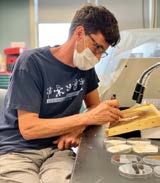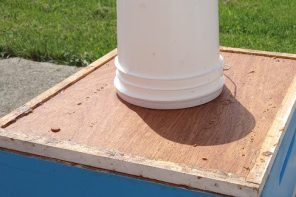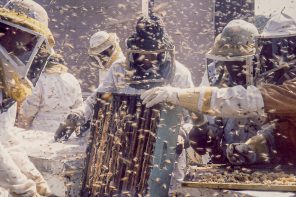Click Here if you listened. We’re trying to gauge interest so only one question is required; however, there is a spot for feedback!
Read along below!
Found in Translation
Save the Males
By: Jay Evans, USDA Beltsville Bee Lab
Male honey bees are not afforded much respect. If a male bee had the mojo to write a memoir it would be entitled “Eat, Mate, Die: One bee’s journey toward the audible pop”. No movie options there, despite the sadists just waiting for the dramatic ending. Nevertheless, these droning lives are critical for the generational success of honey bee colonies. Recent research has explored how male bees, fragile though they might be, contribute to colony health and the longevity of laying queens. There are also new insights into how biological and environmental threats impact males and thereby colony success.
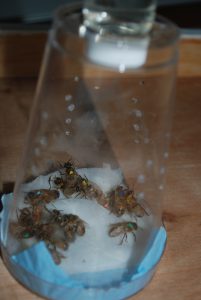 First, male bees truly do have a smaller behavioral repertoire than females. Males are also sheltered from many of the stresses faced by worker bees and long-lived queens. The typical male bee, following a leisurely 24-day development time, emerges from his roomy honeycomb cell and simply ‘lives’ for more than a week before taking his first flight from the colony. No glands to produce wax, no glands to provide buttery food for developing bees, no grooming, no feeding of others, no defending the colony. During this time, the male’s energy is funneled into massive flight muscles and impressively large testes. When scientists look at male performance, they look at these two factors; can the boys fly and can they make viable sperm?
First, male bees truly do have a smaller behavioral repertoire than females. Males are also sheltered from many of the stresses faced by worker bees and long-lived queens. The typical male bee, following a leisurely 24-day development time, emerges from his roomy honeycomb cell and simply ‘lives’ for more than a week before taking his first flight from the colony. No glands to produce wax, no glands to provide buttery food for developing bees, no grooming, no feeding of others, no defending the colony. During this time, the male’s energy is funneled into massive flight muscles and impressively large testes. When scientists look at male performance, they look at these two factors; can the boys fly and can they make viable sperm?
For the first question, it is important to determine if stressed males even live long enough to fly. Recent work by Alison McAfee and colleagues from the University of British Columbia and North Carolina State University showed that drones are more sensitive than worker bees to both cold temperatures and one pesticide (imidacloprid) under high lab exposure rates (Drone honey bees are disproportionately sensitive to abiotic stressors despite expressing high levels of stress response proteins. 2021. Communications biology 5,141, https://www.nature.com/articles/s42003-022-03092-7). Specifically, most drones simply can’t endure four hours at temperatures just above freezing, while their female counterparts survive fine. In this same study, drones died at two-fold higher rates than their sisters after exposure to 100 ppm imidacloprid. When exposed to a cocktail of field-expected pesticide doses, both drones and worker bees survived fine in these trials, but the evidence that drones were disproportionately sensitive overall prevailed.
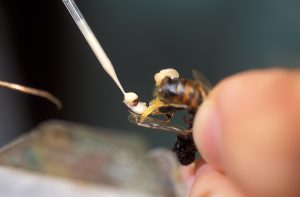
Collecting semen from a drone honey bee that will be used to artificially inseminate a queen bee.
What about sperm? Much has been written about the impacts of drone sperm quality on colony health, using techniques mastered by retired USDA scientist Anita Collins (i.e., Collins, A.M. Relationship between semen quality and performance of instrumentally inseminated honey bee queens. 2000. Apidologie, 31, 421–429, https://www.apidologie.org/articles/apido/abs/2000/03/m0307/m0307.html). But what is it, outside of the lab, that leads to inviable drone sperm? Like most traits, both genes and the environment play a role. In a recent colony-level study, Lars Straub and colleagues measured the impacts of pesticide stress on “all the things drones are asked to do” (Negative effects of neonicotinoids on male honey bee survival, behaviour and physiology in the field. 2021. Journal of Applied Ecology, 58, 2515–2528. https://doi.org/10.1111/1365-2664.14000). Drones exposed to field-realistic chemical doses via pollen patties fed to their colonies died at twice the rate of controls. When they survived, exposed drones took longer than controls to take their first flight, drifted more often to the wrong colony and produced a higher ratio of defective sperm.
Does that defective sperm translate into poor colony health? Jeffery Pettis and co-authors showed that queens heading failing colonies in commercial beekeeping operations carry a higher proportion of damaged sperm (Pettis JS, Rice N, Joselow K, vanEngelsdorp D, Chaimanee V. Colony failure linked to low sperm viability in honey bee (Apis mellifera) queens and an exploration of potential causative factors. 2016. PLOS ONE 11(5): 0155833. https://journals.plos.org/plosone/article?id=10.1371/journal.pone.0147220). Sixty percent of the sperm stored by queens in failing colonies was dead, while only 30 percent was dead in healthy colonies. This need not reflect a history of dysfunctional dads in that poor sperm health might reflect the abilities of queens to keep sperm viable rather than damaged goods from the start. In fact, the researchers found higher levels of dead sperm after queens were subjected to temperature stress, passing the blame for sperm health to queens or (more likely) queen transport and management. While it is tough to measure the longterm effects of inadequate males on colony health, headway was made with data and a model generated by Bradley Metz and David Tarpy from North Carolina State University (Reproductive and morphological quality of commercial honey bee (Hymenoptera: Apidae) drones in the United States. 2021. Journal of Insect Science, 21: 2, https://doi.org/10.1093/jisesa/ieab048). Observationally, colonies produce a range of smaller and larger drones, with six to 10% of drones being below a threshold size mimicking that seen when drones are raised mistakenly in worker cells. These smaller drones differed in their abilities to pass on adequate sperm in both quantity and quality (sperm viability), and the authors use that fact to argue that less fit males can have a strong impact on queen longevity and the health of managed bee colonies.
Weirdness in male bee genetics play some role in their fragility. Male bees, like male ants and wasps, and males found in a handful of less prosperous insect groups, are generally ‘haploid’ from birth to death. They are born of unfertilized eggs that simply start dividing into tissues and eventually organs, forming a viable insect that has no genetic father. Being haploid comes with its own set of challenges. Most life forms outside of the bacteria and ‘archaea’ have a genetic father and mother. This means we have two copies of genes that encode most of the proteins in our bodies. This redundancy can be good as organisms develop, behave and prosper. For example, many survivable genetic diseases in humans and other organisms are survivable simply because one of two viable proteins in such cases can suffice for a critical life task. As scientists have noted, honey bee drones are thus uniquely vulnerable to dysfunctional proteins encoded by their exposed genomes. The work previously mentioned, by Dr. McAfee and colleagues, for example, contrasted males and their sisters specifically to see if males were the weaker sex because they are haploid or because of other biological differences. Their study suggests the latter. Nevertheless, there are surely impacts from having half a set of chromosomes in terms of breeding and bee evolution. Garett Slater and colleagues, in Haploid and sexual selection shape the rate of evolution of genes across the honey bee (Apis mellifera L.) genome (2022. Genome Biology and Evolution. 14(6) https://doi.org/10.1093/gbe/evac063) showed that genes that were especially active in male bees were evolving differently than genes equally active in both sexes, although it is not clear that this reflects playing with half a deck. The genetic impacts of being haploid, and the potential for this phenomenon to be exploited in bee breeding, are good topics for next month. Thanks to a handful of female and male scientists who have looked past the limited behavioral range of male bees, we now have critical information on the colony and environmental factors that conspire against drones, and the impacts of drone health on colony offspring borne from their brief and dramatic lives.






